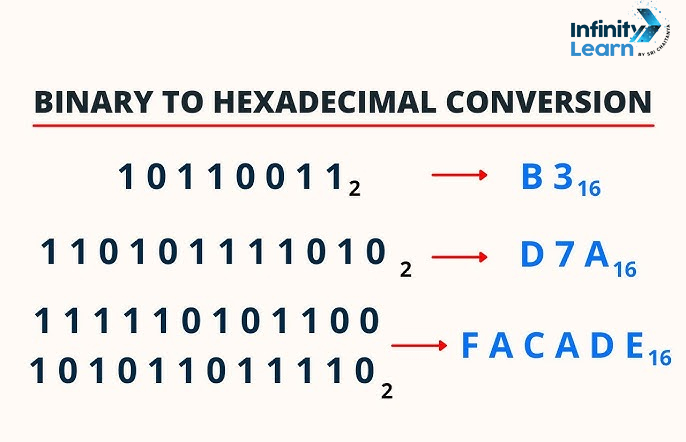Table of Contents
What is Binary to Hex Conversion?
Converting binary numbers to hexadecimal is a fundamental operation in computer science and digital electronics. Our Binary to Hex Converter simplifies this process, allowing you to effortlessly convert binary values to hexadecimal equivalents.
Binary and Hexadecimal (Hex) are two numeral systems used to represent numbers, particularly in the context of computing and digital systems.
Binary
Binary is a base-2 numeral system, which means it uses only two symbols to represent numbers: 0 and 1. Each digit in a binary number represents a power of 2.
Hexadecimal (Hex)
Hexadecimal is a base-16 numeral system, which means it uses sixteen symbols to represent numbers: 0 to 9 and A to F (where A represents 10, B represents 11, and so on up to F, which represents 15). Hexadecimal is often used in computing and programming as a shorthand way to represent binary numbers.

How to Convert Binary to Hex
To convert binary to hexadecimal, follow these steps:
- Convert Binary to Decimal: Convert the binary number to decimal.
- Convert Decimal to Hexadecimal: Convert the obtained decimal to hexadecimal.
Example 1:
Convert binary 11011002 to hex:
Convert every 4 binary bits (from bit0) to hex digit:
11011002 = 110 1100 = 6 C = 6C16
Example 2:
Convert 10010012 into a hexadecimal number.
Solution: 10010012
= 0100 1001
= 4916
| Binary | Hex |
| 0000 | 0 |
| 0001 | 1 |
| 0010 | 2 |
| 0011 | 3 |
| 0100 | 4 |
| 0101 | 5 |
| 0110 | 6 |
| 0111 | 7 |
| 1000 | 8 |
| 1001 | 9 |
| 1010 | A |
| 1011 | B |
| 1100 | C |
| 1101 | D |
| 1110 | E |
| 1111 | F |
Conversion from Binary to Hexadecimal Number System
To convert a binary number to its equivalent hexadecimal representation, you can follow these steps:
- Group the binary digits into sets of 4 bits from the right to the left, adding leading zeros if necessary to complete the leftmost group.
- Replace each group of 4 bits with its corresponding hexadecimal digit using the following conversion table:
- If the binary number contains a radix point (decimal point), group the bits on both sides of the radix point separately.
- The resulting hexadecimal digits on the left and right of the radix point represent the integer and fractional parts, respectively.
Example1 :
Convert (1110)₂ to hexadecimal.
Group the binary digits into sets of 4 bits: (1110)₂
Replace each group with its corresponding hexadecimal digit: (1110)₂ = (E)₁₆
Example 2:
Convert (0.11001)₂ to hexadecimal.
Group the binary digits into sets of 4 bits: (0.1100 1000)₂
Replace each group with its corresponding hexadecimal digit: (0.11001000)₂ = (0.C8)₁₆
By following these steps, you can easily convert any binary number to its equivalent hexadecimal representation.
FAQs on Binary to Hex converter
How do you convert from binary to hexadecimal?
To convert from binary to hexadecimal, follow these steps: Group the binary number digits into sets of 4, starting from the right. If the leftmost group has fewer than 4 digits, add leading zeros to make it a complete group. Write down the hexadecimal equivalent for each group of 4 binary digits using the binary-to-hexadecimal conversion table.
What is the equivalent of 01011010 to hexadecimal?
The binary number 01011010 is equivalent to the hexadecimal number 5A.
What is binary 0000 in hex?
The binary number 0000 is equivalent to the hexadecimal number 0.
What is hex 16 in binary?
The hexadecimal number 16 is equivalent to the binary number 00010000.
What is 32 bits in binary?
32 bits in binary can be represented as a sequence of 32 zeros and ones.
What is 255 hex in binary?
The hexadecimal number 255 is equivalent to the binary number 11111111.









